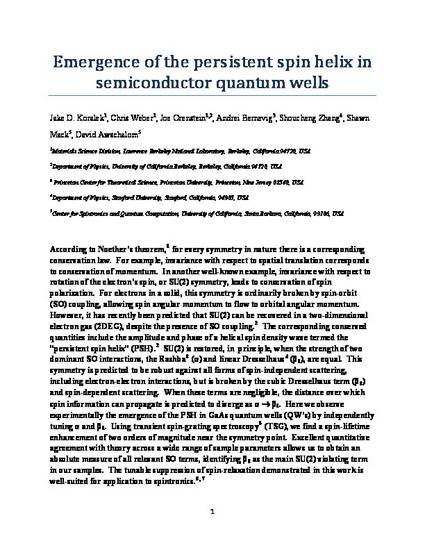
According to Noether’s theorem1, for every symmetry in nature there is a corresponding conservation law. For example, invariance with respect to spatial translation corresponds to conservation of momentum. In another well-known example, invariance with respect to rotation of the electron’s spin, or SU(2) symmetry, leads to conservation of spin polarization. For electrons in a solid, this symmetry is ordinarily broken by spin–orbit coupling, allowing spin angular momentum to flow to orbital angular momentum. However, it has recently been predicted that SU(2) can be achieved in a two-dimensional electron gas, despite the presence of spin–orbit coupling2. The corresponding conserved quantities include the amplitude and phase of a helical spin density wave termed the ‘persistent spin helix’2. SU(2) is realized, in principle, when the strengths of two dominant spin–orbit interactions, the Rashba3 (strength parameterized by α) and linear Dresselhaus4 (β1) interactions, are equal. This symmetry is predicted to be robust against all forms of spin-independent scattering, including electron–electron interactions, but is broken by the cubic Dresselhaus term (β3) and spin-dependent scattering. When these terms are negligible, the distance over which spin information can propagate is predicted to diverge as α approaches β1. Here we report experimental observation of the emergence of the persistent spin helix in GaAs quantum wells by independently tuning α and β1. Using transient spin-grating spectroscopy5, we find a spin-lifetime enhancement of two orders of magnitude near the symmetry point. Excellent quantitative agreement with theory across a wide range of sample parameters allows us to obtain an absolute measure of all relevant spin–orbit terms, identifying β3 as the main SU(2)-violating term in our samples. The tunable suppression of spin relaxation demonstrated in this work is well suited for application to spintronics6,7.

The final publication is available at Springer via https://doi.org/10.1038/nature07871